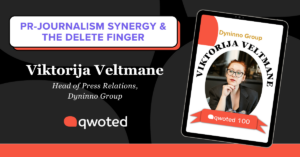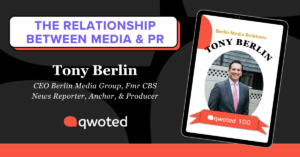Qwoted is committed to exploring the current state of the media by speaking to industry leaders and educating future generations of media professionals. What has social media and technological innovation brought to the table? What can we expect for the future of journalism?
Before Ed Garsten earned his MA in Journalism from the University of Arizona, he had dabbled in local radio by working in a Central New York station in 1973. Garsten began his TV career at KGUN, Tucson, Arizona as general assignment reporter, anchor and newscast producer. He was then hired as one of 10 original producers to launch CNN2, which later became Headline News. For the next 20 years, Garsten moved up through CNN’s ranks from a newscast producer to correspondent and anchor before eventually serving as Detroit Bureau Chief. He covered everything from natural disasters to sports to the automotive industry, and some of Garsten’s most memorable moments are covering Pete Rose’s ban from baseball and suicide doctor Jack Kevorkian.
After CNN closed the bureau in 2001, Garsten was hired as the National Auto Writer for the Associated Press. A year later, he was recruited by The Detroit News as the General Motors beat writer. In 2005, then DaimlerChrysler (now Fiat Chrysler Automobiles), hired Garsten as the first head of its digital communications team. He retired from FCA in 2016 and now works as a Senior Contributor for Forbes Online on automotive coverage. Garsten is also the Integrated Media Consultant for Franco PR, a Detroit media relations firm.
If there’s one thing you could change or improve about journalism—in any area—what might that be and why?
EG: More straight-forward reporting based on facts, rather than analysis and opinion. Newscasters must abandon the insertion of their personal biases in stories and stick to delivering the facts. Also, enough with endless, useless panel discussions talking about stories, and focus more on actual stories from field reporters.
What do you see as some of journalism’s biggest potential pitfalls? And what gives you hope for the future of journalism?
EG: A huge pitfall is the current industry’s need to be first, rather than right. That’s what propagates what has become known as “fake news.” What gives me hope is the public demanding the truth, and younger folks willing to be strong enough to tell it.
What learnings have made a tremendous difference in your career?
EG: Understand why a story will be important to your audience. Remain devoted to accuracy. When writing a lead, hark back to a question my reporting instructor in grad school always asked when reading a weak lead, “Who gives a rat’s @$$?”
What do you think about the role of technology in journalism? Is it helpful? harmful? Something in between?
EG: Technology has been a blessing and curse. We can accomplish more faster, more efficiently and less expensively. But technology, including 24-hour cable news networks, has destroyed the concept of news cycles, often forcing organizations to publish, post or air content without sufficient editing or reporting.
What advice would you give to aspiring young writers and reporters?
EG: Hone your writing skills and remember to spell check. Stick to the facts, and slow down enough to be accurate. Don’t be tempted to compete with malevolent actors and misinformation. Be observant and stick to your ethics.
Where do you get YOUR news from? Which publications do you like to read?
EG: The New York Times, The Washington Post, Associated Press, local Detroit papers (I still subscribe to print edition of the Detroit Free Press), Forbes.com, Google News and various automotive publications.



